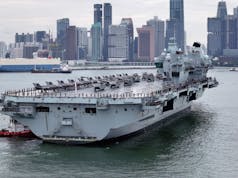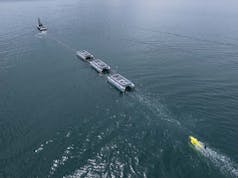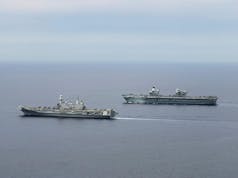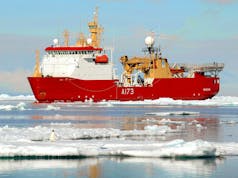Minehunter HMS Bangor has left Faslane for a two year mission to the Gulf.
The Royal Navy say here that the Sandown-class ship faces a journey of more than 6,000 miles to reach her future patrol ground.
“She’ll spend it in company with HMS Middleton, which is also Gulf-bound, having departed Portsmouth on Monday; she’ll do a like-for-like swap with HMS Brocklesby, which will sail back to the UK with Shoreham. This is the 15th year that the Royal Navy has maintained a continuous minehunting presence in the kingdom, working with allies and partners in the region to keep sea lanes open, hone mine warfare skills and generally promote peace and stability.”
Lieutenant Commander Rob Couzens, the ship’s Commanding Officer, was quoted as saying:
“It’s been a very busy year for Crew 8 and HMS Bangor,” said Lieutenant Commander Rob Couzens, the ship’s Commanding Officer. We started with getting the ship ready to proceed to sea after a very in-depth maintenance period, conducted operational sea training which tested the ship and crew to extremes – all while dealing with the effects of Covid and the difficulties that created including separation from loved ones. Crew 8 has fought hard and got HMS Bangor ready to deploy on operations and we are all very much looking forward to our transit out to the Gulf and what the rest of the year has in store for us.”
The Royal Navy also add that the crews of Sandown-class vessels are gradually transitioning from the existing ships to the new autonomous force, spearheaded by the three new craft Hebe, Harrier and Hazard, led by the squadron’s Crew 7 who came home from the Gulf earlier this summer ready to grasp the future.













Bloody hell… I remember when Bangor was out here last time!!!
I do hope that the RN can find the funds for a few ‘mother ships’ to support the autonomous boats at some point in the future. Probably, not so important in the Gulf but there will be areas / occasions where land basing of such small vessels is not feasible e.g. if the mine threat is a significant distance from a usable port or accessible coast line. Not all choke points necessarily have a friendly port near by.
The vessels need not be expensive or complex. There are a lot of oil field support vessels becoming surplus to requirements so a second vessel with a large flat deck and powerful crane could be cheaply converted to MCM support vessel, especially as the future MCM capability is going to be containerised!
You could probably hire such vessels on a long lease basis similar to the approach for the Point Classs Ro-Ro vessels.
I would also point out the ‘choke points’ are not necessarily defined by narrow seas, but rather by navigational rules of the sea controlling large numbers of large ships as they approach ports or narrow seas. HMS Audacious was sunk in 1914 by a floating mine of the coast of Co Donegal, the chock point being defined by the North Western Approaches to the UK / Clyde and Northern Europe.
Modern mines laid in the rough Western Approaches would still need to be dealt with and those small autonomous boats couldn’t deal with that threat. So larger more sea worthy vessels will still be needed, I would suggest, autonomous or manned.
Having said all of that the RN is doing the right with regards to adopting the autonomous technology, I just hope the politicians do not think that mines are only laid in shallow coastal water where the boats make sense.
Cheers CR
I haven’t done the maths for length and beam but I wouldn’t be surprised if given some clever cradles you couldn’t fit 15m Hebe, and 11m Hazard and Harrier on the flight deck of a River 2. The crane can lift 16tons.
https://www.royalnavy.mod.uk/news-and-latest-activity/news/2021/june/21/210621-final-autonomous-minehunter-delivered
Sound thinking there CR, I assume the mission bays on T31/26/32 class will be able to handle these assets??
A T31 would be the ideal mother ship in a contested area (if the autonomous mine clearance assets fit in the mission bays), assuming they get 24 Sea Ceptor, it would take a determined and large air attack to get through that lot!
The gun armament is pretty ferocious for Fast attack craft and drones, add Martlet to the package and the Wildcat and you have a robust and well protected mine clearance package.
Hi John,
I agree with everything you say, but my concern is that much of the MCM work is long term and on-going even during wartime. There is not always the need for any kind of conventional fire power for these operations as mines are often used to disrupt shipping where combat vessels would struggle to maintain a presence, e.g. Russian Navy in the Western Approaches. Why would they take the risk when they could sneak in with a mine laying sub, deploy some smart mines and get out before we even knew they were there.
So if Russia is the main threat then the Western Approaches should be the priority area of operations for escorting and protecting shipping. That means deep water MCM ops as well as coastal work. So a bigger boat will be needed than the 15m RNMB Hebe. Which then means bigger mother ships and remember the Western Approaches can get pretty lumpy for pretty much most of the time and it is only going to get worse with climate change. We have just had the first storm of the season in the south west, an October Gale in July! Uh Uh, not good.
So whilst the T31 / T32’s would be very capable (particuarly the T32 I would hope) the plan is for only 5 of each class, so 10 hulls. The T32 is also slated to carry ASW autonomous vessels so they are going to be spread pretty thinly, as usual.
Hence, my suggestion for converted STUFT vessels. These could take on long term MCM operations freeing up T31 / T32 of whatever other mother ships are procured for the more dangerous or contested operational areas.
Cheers CR
I totally agree with your assessment of the situation CR. During this decade, the oil and gas industry will start to contact as demand starts to reduce.
It stands to reason that sea based oil and natural gas will be the first to go as the costs involved will reduce its commercial viability.
As you say, some of the ships designed for rig support are perfect for converting as Mine warfare motherships, ‘extremely tough’ and seaworthy by design and necessity, with a large reinforced cargo deck, high capacity cranes and designed for lean manning.
Perhaps build a multi purpose Drone/ Helicopter/ MCM boat hanger and they would require internal mods to allow comfortable enduring missions, suitable cabins, galley/ kitchen/ storage etc.
Would they be RN or RFA assets I wonder? I would suggest making them RN assets, as attacking a vessel flying the white ensign will make for very serious repercussions!
Hi John,
RFA or RN crewed the MCM specialists would be RN obviously. So if these ships were to be used in ‘low’ risk missions e.g. as in the current ‘peaceful’ Middle East / Gulf mission I would suggest they could be RFA manned.
The RFA is used to operating with lean civilian style manning (it is only 1800 strong in total) so would be the obvious way forward under those mission constraints.
I would also point out that the RFA has been used for years as a, ‘hello we’re interested’ message carrying. In the past if something was going on that the UK was concerned about an RFA would appear in the local harbour and being ‘unarmed’ didn’t need to give prior warning of its arrival as it was civilian registered – but being painted grey indicated that trouble could be lying just below the horizon! It usually worked apparently.
So I would suggest firing on an RFA even these days would represent just as serious repercussions as firing on an RN vessel, notwithstanding the RFA might be unarmed or very lightly armed.
For the more dangerous areas I think it would be justifiable to use a T31 / T32 as they are or will be warships with a few obvious thunder sticks mounted 🙂 .
Cheers CR
Hi Paul,
I agree provided that the cranes on the OPV’s can handle the weight. The 15m Hebe i sa pretty big boat and oddly the Batch 2 Rivers are fitted with a only a 16ton crane whereas the Batch 1 vessels are equipped with a 25ton crane.
I cannot find out how heavy the work boats are, but the 15m RNMB Hebe is pretty big and can be loaded with significant quantities of mission equipment. I would be surprised if it was over 16 tons, but I would be happier with a 25ton crane.
The intention is that the T32 will be mother ship for autonomous vehicles including the MCM craft, which suggests to me that the RN is going to loose deep water mine clearing capability or at least face additional deep water limitations. The T32’s will also carry ASW autonomous vehicles, at least that is the plan. If only 5 T32 are built and they take on MCM work escort availability may not improve as much as we all hope. Of course, they may well build more than 5 T32, in which case happy days. I guess we’ll find out in about 15 years time..!
Cheers CR
It was just a thought; that maybe we don’t have to wait for T32 mission bays to start deploying the autonomous mine clearance systems. I don’t see a need the R2s posted to the Caribbean, Falklands being tasked in this way. And I don’t know the endurance or remote control range of the unmanned vessels. For a narrow passage I suppose you are be able to launch the USVs from land and have the operator with the games console work from shore or any other vessel with a radio transmitter. Since HMS Bangor is going to the Gulf it seems that the Sandowns will still be part of the way of working there. Looking at the map the international channel through the straits of Malacca looks narrow and vulnerable to malicious minelaying. Maybe Tamar and Spey will be trialled in this way.
Hi Paul,
I am going to respectively disagree with you regarding the Caribbean and Falklands patrols.
The Falkand Islands Exclussive Economic Zone (EEZ) extends to about 300km to the north, east and south and to about 100km to the west where it boarders the equivalent Argentinan EEZ. This is a huge area to ‘protect’ and with no MPA available the only option is to use an OPV. Also, the withdrawal of the OPV might encourage Argentina to have ‘another go’. So I vote for keeping the Falkland patrol in place.
The Caribbean patrol is more about maintianing relationships with our friends and allies in the Caribbean including the USA. The US Coastguard is known to value working with the RN and regularly deploys its people with the RN. Withdrawing the patrol for permanently would not go down well in Washington. Also, the OPV has become an intergal part of the UK’s support for Caribbean Commonwealth nations and UK dependencies during the Hurricane season, especially given the increasing use for small camera equipped drones for reconnaissance missions as part of the rapid relief planning process. So again I vote for keeping the OPV in the Caribbean.
BAck to the MCM question. Conversations with experienced posters such as Gunnerbuster and others, highlight that MCM is a weather limited task, i.e. you don’t go looking for mines is a storm! So your point about the range of shore launched small boats is the main point I have. Command and Control of the autonomous vehicles is a key limitation, although use of aerial autonomous vehicles as signal relays is an obvious way to get around this in low threat environments.
The boats themselves could have a significant range as RNMB Hebe is 15m I would suggest that she could stay at sea for quite sometime, may be 24hours given low spead operations fo rmuch of the time (?), although I cannot give precise data.
For longer range operations in narrow seas one of the existing MCMV could act as a refueler / C2 platform as you suggest. So I think the RN is looking really good in the short to medium term. The longer term when the current Sandowns and Hunts are all retired is my concern. I do not think the current small boats will meet the full range of challenges.
It has occured to me that deep water MCM could be undertaken by submersible MCM. Best way to avoid the weather at sea, go under it! Such craft would probably need to be quite large to provide for extended mission times so a larger mothership with some serious lifting gear would be required.
Cheers CR
Oops, sorry for confusing things. I meant to say I didn’t see Forth and Medway (I think) needing to trial being mother ship to autonomous MCM, not that they should be withdrawn. Completely agree Falklands and Caribbean OPVs are necessary. My thinking was just focussing on ‘choke points’.
I can appreciate the difficulties posed by deep water and rough weather in general terms but have to hand over to experts such as yourself and GB when it comes to detail practicalities Good discussion though.
Cheers P.P.
🙂 Ah, now that makes sense – no worries mate.
Thanks for elevating me to ‘expert’. I have some limited professional experience on the naval front, mostly air and joint stuff and a lifetime of interest and reading. GB is one of the genuine naval experts on here. (Also, if I have time I’ll have a dig around online before posting, but don’t let on 🙂 ).
Cheers CR
I wonder if the ships motto is:
“Fiddlers dram”
I’ll get me coat.
Didn’t we have a lovely time.
I saw her in Bangor two weeks ago, she was looking well.
Still sounds weird to me ‘crew 8’ instead of the ships company. Hey ho, you can’t get in the way of progress.
Happy trip lads and lasses